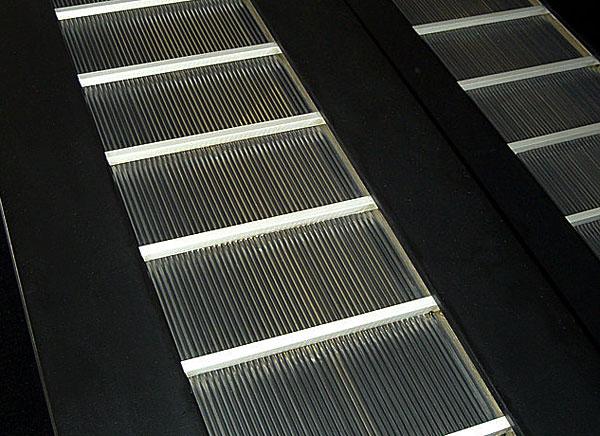| Columns Retired Columns & Blogs |
Audiostatic ES-100 loudspeaker

Thanks to Ben Peters, there's an electrostatic lifeline in Holland. Founded about 25 years ago, his company, Audiostatic, struggled through the 1980s, but with distribution by SOTA Industries, it's now on firm footing in the US. In fact, SOTA's Jack Shafton told me that all assembly and some manufacturing are now conducted in the US. My ES-100 samples came from the first US production run.
The speakers arrived on my doorstep via motor freight. Despite the crate they arrived in being made from wood, I discovered a narrow hole in its side—apparently the result of a forklift-blade attack. As destiny would have it, the blade pierced the crate exactly between the speaker panels, so no harm was done.
Technical details
The ES-100's essence is one elegant electrostatic panel. This is a full-range transducer—a single diaphragm reproduces the entire musical spectrum. The Audiostatic's diaphragm is not physically segmented. As a result, it has a noticeable "drum-head" resonance at about 50Hz.
The panel frame is made of 1.5"-thick MDF and is quite sturdy. A thin, conductive-plastic diaphragm just 5µm thick is sandwiched between stationary stator electrodes, these insulated wires running from top to bottom. A bias DC voltage (in the thousands-of-volts range) is applied to the diaphragm, while the audio signal is stepped-up in voltage and applied in opposing phase to the two electrodes, creating a push-pull force on the diaphragm. (Electrostatic speakers have a significant advantage over other types of planars—ribbons, for example, whose diaphragms must be more massive because they have to conduct high currents.)
The electronic interface is mounted on the panel's backside. A tiny 12V AC wall transformer provides the bias voltage. The interface back plate is adorned with the bias voltage jack and a single pair of binding posts. No bi-wire options here. There are no user controls on the interface, which lacks both bias-adjust and tone controls. The interface's size, with its small step-up transformer, doesn't suggest no-compromise high-end standards. Rather, it gives the impression that the ES-100 is an entry-level product. The panel/interface assembly is not light as a feather, but I had no trouble hoisting the speaker into my listening room.
As far as assembly goes, I only needed to attach the floor plate to the bottom of each panel. Since this plate is lightweight and only a square foot in area, it does little to stabilize the speaker, which tended to rock back and forth on the carpet. I weighed the base down with a Bright Star Audio Little Rock Isolation Pod. A more substantial base, perhaps one filled with sand or lead shot, would greatly improve the assembly's overall structural integrity.
Such a superbase would work well with spikes or Tiptoe-like feet to anchor the speaker to the floor. While the standard floor plate doesn't come with any sort of spikes, SOTA did send me a set of six Isocoin Vibration Dampers ($120)—Audiostatic's aftermarket accessory for controlling vibrational energy. The Isocoin is a multi-layered sandwich of two outer polyamide (hard plastic) "coins" with a springy plastic vertical layer in the middle. A small metal ball is wedged in the upper coin. The instructions state that these dampers were designed to maximize the performance of Audiostatic ESLs by "effectively de-coupling the speaker system from the floor." You should use three Isocoins per speaker—two in front, one in the rear. They should be positioned under the speaker base with the ball facing down.
On my listening room's carpeted floor, the Isocoins further destabilized the speaker assembly—to the point where I was afraid the speaker would tumble. With basic physics in mind, I can't see how this product can work at all when it's sitting on carpet-covered foam. The Isocoins may work well between two hard surfaces, but there's nothing in the instructions cautioning against using them on a carpet. Needless to say, the Isocoins went back in the box.
Preliminaries
A search for a new loudspeaker should never be consummated with disregard for a matching amplifier—the quest usually hinges on finding a synergistic speaker/amplifier interface. People often ask me for loudspeaker recommendations. Of course, my answer depends on whether or not the person asking is willing to get a new power amplifier. If not, then we must consider what's optimum for the user's existing amp. So it goes with the ES-100. This is a fairly insensitive speaker, and its impedance resembles that of a capacitor, with a magnitude that's large in the bass but which decreases with increasing frequency. Fortunately, the minimum impedance is specified as 6.5 ohms. Overall, this speaker needs an amp that can dish out at least 100W into a capacitive load without complaining. For tonal balance, a tube amp would do better here than would a solid-state design. From my ample collection of tube amps, the Fourier Components Sans Pareil Mk.II OTL (Follow-Up in progress) emerged as an awesome partner and allowed me to flesh out this speaker's full potential. The excellent TARA Labs RSC speaker cable was used throughout.
Radpats
A basic performance aspect of any loudspeaker is its radiation pattern. "Radiation" may be a distressing term to anyone who grew up during the Cold War, but it can also be used generically to describe energy in motion—in this case, the term refers to sound waves launched by the speaker's diaphragm.
- Log in or register to post comments




































